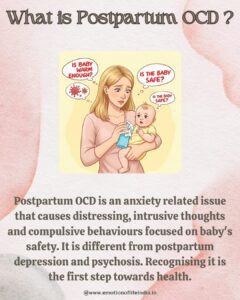
Postpartum Obsessive-Compulsive Disorder
Postpartum Obsessive-Compulsive Disorder is a unique form of OCD that develops after a person has given birth. While postpartum depression (PPD) is widely discussed, postpartum OCD remains underrecognized despite its significant impact on affected individuals. This article aims to provide an in-depth understanding of postpartum OCD by examining its symptoms, types, causes, and potential solutions.
Defining Postpartum OCD
Postpartum OCD is characterized by the presence of intrusive, distressing, and repetitive thoughts (obsessions) and/or compulsive behaviors aimed at reducing anxiety. Unlike general OCD, postpartum OCD specifically involves themes centered around the newborn’s safety and well-being. These obsessive thoughts and compulsions often cause severe distress, disrupting the mother’s daily functioning and affecting her ability to bond with her child.
One of the defining features of postpartum OCD is the disconnect between the nature of the intrusive thoughts and the individual’s intentions. Unlike psychotic disorders where hallucinations or delusions may influence behavior, individuals with postpartum OCD are highly aware that their thoughts are irrational and experience extreme distress because of them. This distinguishes postpartum OCD from postpartum psychosis, a far rarer and more severe condition requiring immediate medical attention.
Symptoms of Postpartum OCD
Postpartum OCD manifests through a combination of cognitive, emotional, and behavioral symptoms, which can be categorized into:
Psychological Symptoms:
- Intrusive, unwanted thoughts about harming the baby (e.g., fears of dropping, smothering, or otherwise endangering the infant)
- Repetitive mental images of catastrophic scenarios
- Overwhelming guilt or shame over intrusive thoughts
- Intense fear of being left alone with the baby
- A heightened sense of responsibility for the baby’s well-being beyond reasonable parental concern
- Persistent doubt about whether they have completed necessary tasks (e.g., locking doors, turning off stoves, ensuring the baby is breathing)
Physiological Symptoms:
- Increased heart rate and shortness of breath when experiencing intrusive thoughts
- Difficulty sleeping, even when the baby is asleep, due to heightened anxiety
- Physical tension and restlessness
- Fatigue resulting from constant hypervigilance
- Gastrointestinal distress caused by prolonged stress responses
Behavioral Symptoms:
- Carrying out repetitive actions, such as frequently sterilizing baby bottles far beyond what’s necessary, is a common compulsive behavior linked to this condition.
- Avoidance of situations that could trigger intrusive thoughts, such as refusing to hold or bathe the baby
- Seeking constant reassurance from family members about the baby’s safety
- Excessive cleaning or sanitizing due to fears of contamination
- Engaging in rigid, self-imposed rituals to prevent perceived harm
Postpartum OCD may be categorized according to the type of obsessive thoughts and compulsive actions involved:
- Harm OCD – Involves distressing thoughts about unintentionally harming the baby, leading to excessive checking and avoidance behaviors.
- Contamination OCD – Characterized by an extreme fear of germs or illness affecting the baby, resulting in excessive sanitization.
- Order and Symmetry OCD – Manifests as compulsive organizing or arranging objects in a specific manner to prevent perceived harm to the baby.
- Religious or Moral OCD – Involves intrusive thoughts that contradict personal religious or ethical beliefs, causing intense guilt and distress.
- Reassurance-Seeking OCD – Repeatedly seeking validation from others to alleviate anxiety about caregiving responsibilities.
Several factors contribute to the development of postpartum OCD, including:
Biological Factors:
- Hormonal fluctuations following childbirth, particularly shifts in estrogen and progesterone levels
- Changes in cortisol and other stress-related hormones impacting cognitive and emotional regulation
- Genetic predisposition to anxiety disorders and OCD
Psychological Factors:
- A history of anxiety disorders, OCD, or perfectionistic personality traits
- High levels of responsibility and fear of making mistakes as a new parent
- Increased hyperawareness of potential risks, leading to excessive vigilance
- Distorted cognitive patterns that amplify fear-based thoughts
Environmental and Social Factors:
- Lack of sleep and fatigue resulting from looking after a newborn
- Lack of adequate social and emotional support
- Experiencing intense stress during pregnancy or shortly after childbirth
Feeling pressured by cultural or family expectations to achieve idealized standards of parenting
While postpartum OCD can be distressing, structured intervention strategies can significantly improve symptoms. The following approaches can be beneficial:
Cognitive Strategies:
- Cognitive Restructuring: Identifying and challenging irrational fears and replacing them with more balanced perspectives.
- Exposure and Response Prevention (ERP): Gradually confronting distressing thoughts without engaging in compulsive behaviors to reduce their intensity over time.
- Cognitive Defusion Techniques: Learning to separate oneself from intrusive thoughts and recognize them as transient mental events rather than indicators of reality.
Behavioral Approaches:
- Mindfulness-Based Techniques: Practicing present-moment awareness to reduce engagement with intrusive thoughts.
- Gradual Exposure: Encouraging small steps toward engaging in feared situations to rebuild confidence in caregiving abilities.
- Sleep and Routine Regulation: Establishing structured sleep and self-care routines to manage stress and cognitive function.
- Behavioral Experiments: Testing out fears in a controlled manner to observe that catastrophic outcomes do not occur.
Supportive Environmental Modifications:
- Delegating non-essential tasks to reduce stress.
- Establishing clear and structured caregiving responsibilities with a partner or family members.
- Educating close family members about postpartum OCD to foster a supportive and understanding environment.
- Creating structured schedules to minimize unpredictability and anxiety triggers.
Long-Term Considerations
Managing postpartum OCD requires ongoing effort, even after acute symptoms improve. Implementing self-monitoring techniques, maintaining open communication with family members, and adopting stress-reduction strategies can aid in long-term well-being. Avoiding excessive self-judgment and recognizing that intrusive thoughts do not define one’s parenting abilities can be crucial in sustaining progress.
Postpartum OCD is a serious but manageable condition that affects many new parents. By recognizing the symptoms early, understanding the underlying causes, and implementing structured cognitive and behavioral strategies, individuals can regain confidence in their caregiving abilities and improve their overall well-being. Increased awareness and education on postpartum OCD are essential for better identification and intervention, ultimately fostering a healthier postpartum experience for both parents and their children.
Given the complexity of postpartum OCD, further research and discussions on individualized strategies remain necessary to refine interventions and improve outcomes. By fostering greater awareness, postpartum OCD can be addressed proactively, ensuring that affected individuals receive the appropriate guidance to navigate their challenges effectively.
You can write to us: info@emotionoflife.in or reach out us via call 9368503416 or visit our website- www.emotionoflife.in
